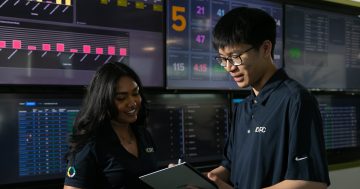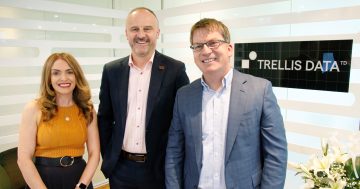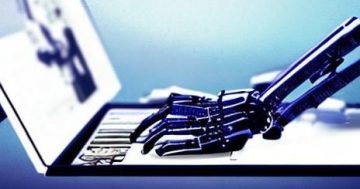The question of AI is being asked everywhere on the planet and Kevin J. Delaney has asked Microsoft’s corporate vice president for Modern Work & Business Applications, Jared Spataro (pictured) for his answer.
 Microsoft over the past few years has released some of the most interesting research about how people work, including analysis of the explosion of meetings since the pandemic started and the “triple-peak” workday phenomenon.
Microsoft over the past few years has released some of the most interesting research about how people work, including analysis of the explosion of meetings since the pandemic started and the “triple-peak” workday phenomenon.
Now, building on its tight partnership with OpenAI, Microsoft is adding features to the many tools used in workplaces to introduce generative AI functionality.
These new capabilities, including Microsoft 365 Copilot, aim to further change the way that knowledge work is done.
To better understand the implications for work and management, we spoke with Jared Spataro, Microsoft’s corporate vice president for Modern Work & Business Applications.
Here are excerpts from our conversation, edited for space and clarity:
“How would you characterise where we’re at in the evolution of knowledge work? And how do you see how we spend our work days evolving over the next two or three years with the rollout of AI tools?”
Spataro replies:
“We’re in the early stages of it. In many ways, the last couple of decades have really essentially been the digitisation of analog work patterns.
“The spreadsheet, as an example, was a digital representation of a ledger book. Word processing evolved from the typewriter. You see these physical analogs that we have digitised.
“In many ways, we were reaching the diminishing returns of that approach and now we’re starting to tip into a new era where we’re truly digital. We’re really thinking about what we can do differently when we’re truly digital. And we’re realizing, especially because of the pandemic and the massive transformation that we’ve had of all sorts of different types of communication that we can apply AI to many of the tasks where we have thought, well, this is just the way it’s done.
“So it’s exciting for me because we’re kind of coming to the close of a first phase of digitization and really entering into a new and very exciting phase.
What are a few things that we do today at work that you think we will stop doing within a few years?
“If I take a step back and look at what in particular AI is doing for me and for the folks who are just getting their hands on it, there are a couple of patterns that we’re seeing.
“Number one, we definitely are seeing AI help us find the signal amid the noise. One of the really interesting facts that we uncovered in analysis of our telemetry was almost 60% of the average worker’s day is spent communicating or coordinating with others. And that percentage continues to grow.
“People feel this, for sure. The way they express it often is, I have a whole job to get to my real job, to be able to do the thing I was hired to do. So I see a pattern emerging where AI is going to help us cut through all of that.
“It’s not like we’ll communicate less. But we’ll be able to find the most important aspects of the communication to help us get our jobs done.
“I also am really intrigued by how AI is helping us spark creativity.
“We’ll see entirely new patterns of human-machine collaboration emerge. I don’t think that means that we’ll collaborate less with people, but it will improve our ability to be creative.
“That’s a unique thought for me. For many years, I thought that machines just wouldn’t be good at creative tasks.
“Then finally, meetings will be pretty transformed. It’s not to say we won’t meet any longer, but I’m finding, for instance, I attend fewer meetings because a meeting has become less a point in time and almost a knowledge object that I can query, that I can ask questions to.
“That’s a whole new way of thinking about human interaction.”
You described meetings as ‘knowledge objects.’ Is that because AI is able to easily transcribe and summarise them?
“Yes, but there’s one other aspect.
“Transcription technology is getting amazing. It’s not error free, but neither are humans when they transcribe. And in my experience, it is far surpassing what a human can do.
“The summarization is incredibly valuable, but for me it’s the next step.
“A summary is good. It gives you an outline of what happened, but oftentimes you want to know more about the human interaction. I’m amazed, for instance, in some of the tools that we’re releasing right now that you can ask very specific questions. Was my name ever mentioned? Was this topic ever mentioned? What was the group’s sentiment on this?
“Not only what decisions did they make, but how did they feel about those decisions? Were there any dissenting opinions? You can get such a fine-grain analysis of human interactions that it really opens your eyes to this idea of wow, it used to be that a meeting happened and it was over and people maybe took sketchy notes.
“These days, that very full interaction can be looked at from many different angles.”
Stepping back, what AI capability or feature do you think will have the greatest impact on knowledge workers over the next few years?
“This one’s pretty easy for me. People ask me this question as if, ‘gosh, Jared, I bet you have a whole bunch and you’re not quite sure.’
“Nope, I have one. It is the emergence essentially of a ChatGPT-like tool for your business.
“ChatGPT is amazing because if you ask it questions about the material that it was trained on, it gives you surprisingly well-reasoned answers, sometimes wrong. And we can talk about hallucination, but surprisingly well-reasoned answers. Answers that can help you if you’re trying to do specific tasks.
“Today we have no such thing as the equivalent of a ChatGPT for your business where you could ask it everything from Q4 sales to current trends to its prediction of how the quarter will end for a certain product line.
That technology is emerging right now and it will come here much faster than people think. It will reshape job design, roles, even dare I say the operating model of a company. Because so many roles are essentially fashioned to make the company move forward and pass information along so that good decisions get made on some of the key aspects of what it means to make a product and sell it. So I think it’s going to be that.
“I think people in finance to marketing to sales are going to spend less time in the traditional applications that have emerged over the last couple of decades and more time simply querying their company, Hey, what about this? What about that? What if we did this? How should I think about this? Do you have any recommendations on that? And that’s a brand new way to think about running a going concern.
Is anything different required from managers to succeed as work evolves over the next few years?
“Oh, we’re at a real turning point for management.
This has been predicted for a number of decades too, but the management philosophy, structures, theses—all the models we’re taught in business school—are all based essentially on post-war industrial complex approaches to organisations.
“Command and control was the first, it’s kind of one of these very big approaches. But beyond command and control, even with some of the smaller, more nimble organizations, they’ve largely been modelled off of traditional structures.
“AI I think is going to disrupt that. Certainly distributed and flexible work is already disrupting that.
“So I think we’re going to look back in five and 10 years and say, wow, the manager that emerged from the confluence of those technologies is just an entirely different person.
“They need to know how to manage the time and energy of the people in their organization across time and space. They have to be able to recognize where augmenting human capacity with machine-based capacity is going to help them get the job done faster, better, higher quality. All of those factors are things that we’ve never really factored in.
“While I can’t predict exactly what that will look like, it’s easy to predict with 100% certainty that the manager of the next even two or three years is going to look very different from the prototypical that’s been trained by business schools over the last few decades.”
A written transcript of the full discussion can be accessed on this PS News link.
*Kevin J. Delaney published this article which appeared in Time magazine.











